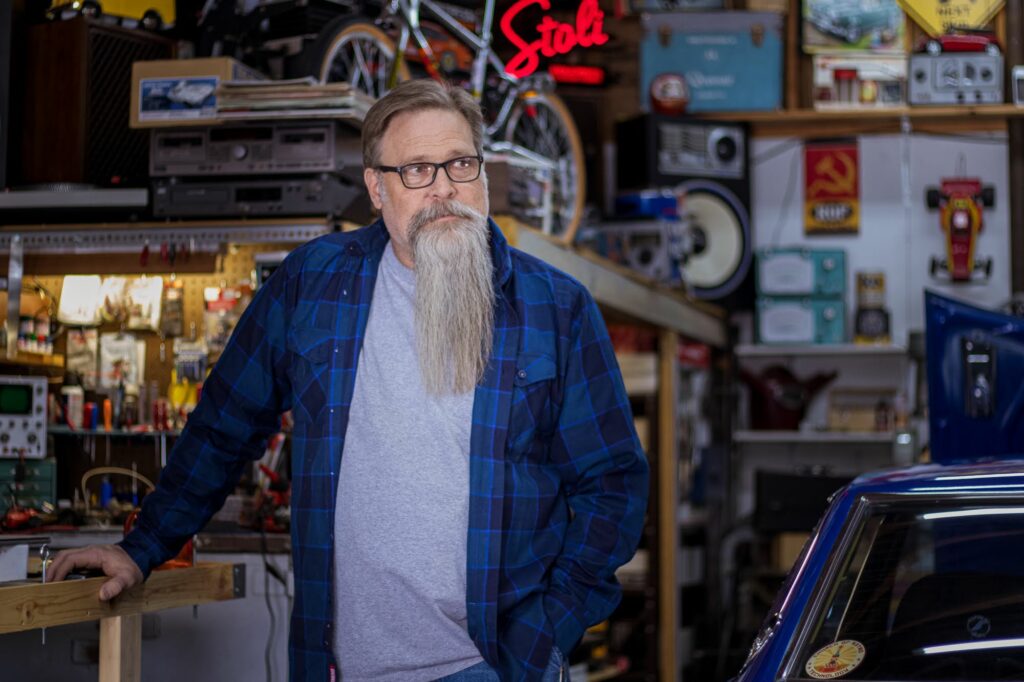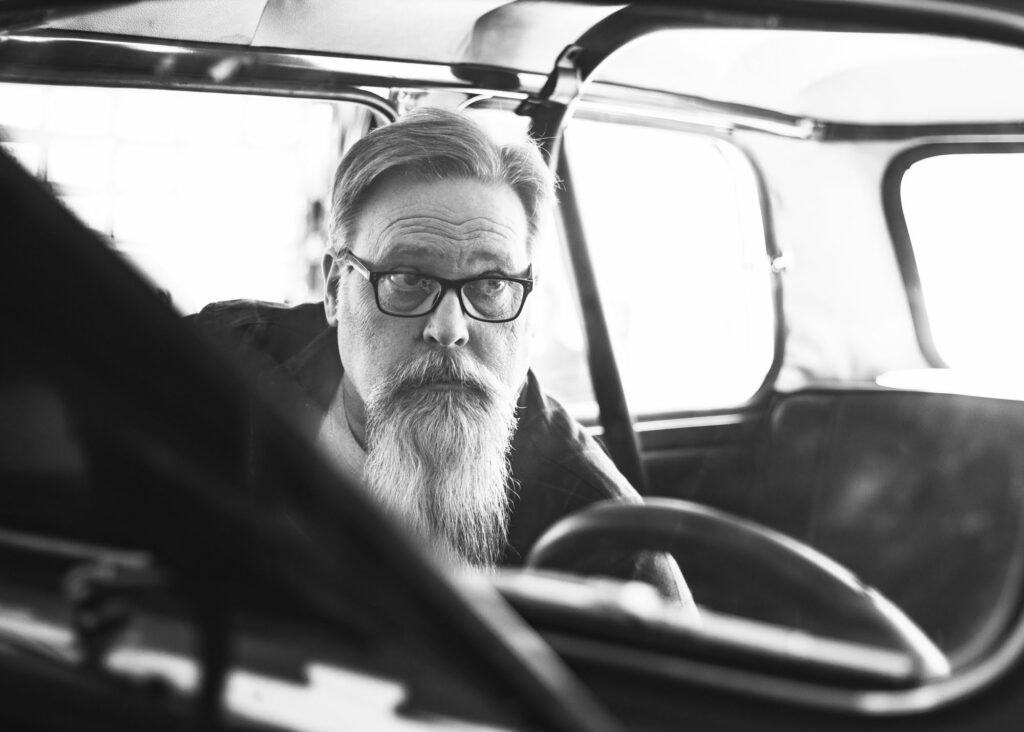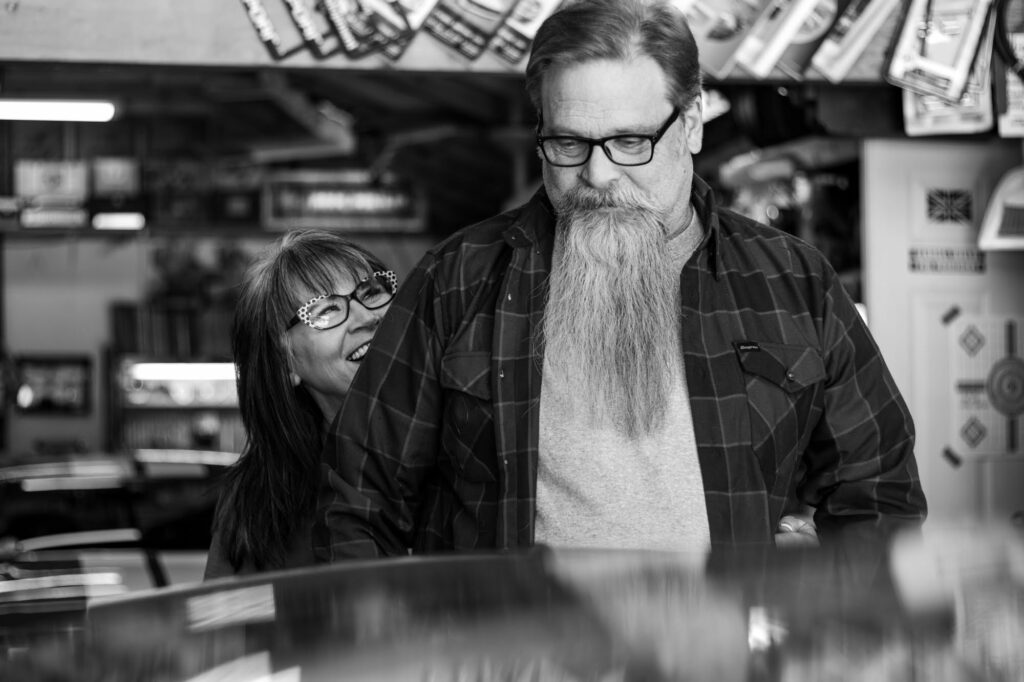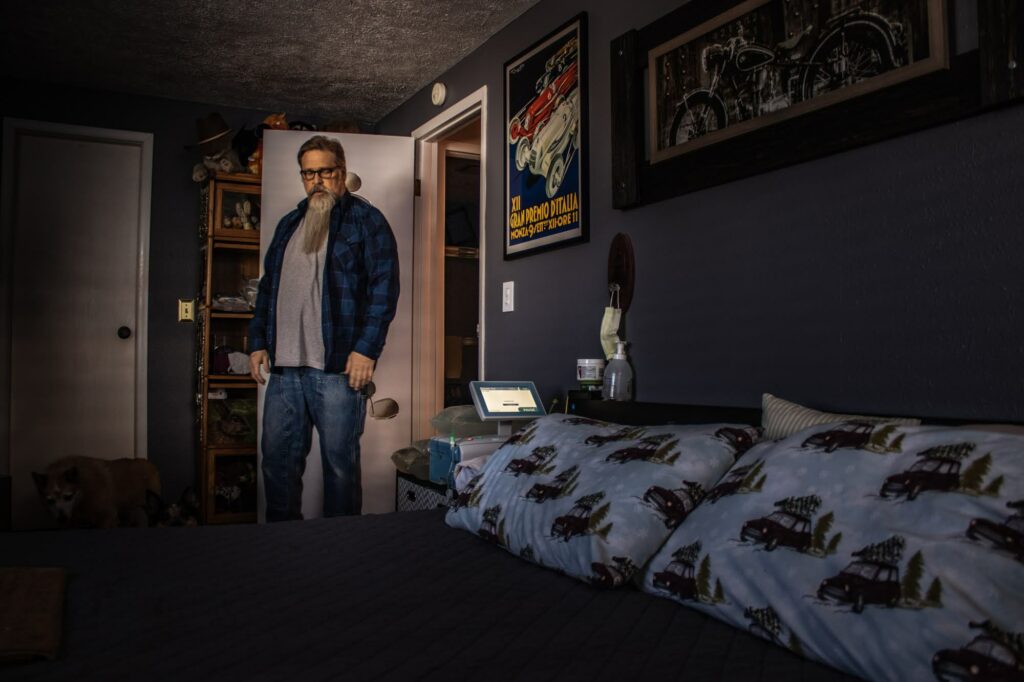Beloved Boulder mechanic in need of kidney transplant

Friday, March 17, 2023
The first time Charlie Bigsby was offered a kidney, things looked promising. The potential donor, a long-time friend, made it through the initial health screen and subsequent testing. But then the news came down: He was prediabetic, and therefore ineligible to donate.
The next friend to offer drove all the way from Kansas City, only to be told he might have heart problems down the road. Another person was in perfect health, but the wrong blood type. A fourth was screened out for unknown reasons, though a long-past history of drug use may have played a role.
Charlie would be offered a kidney three more times. None of them panned out, leaving the 56-year-old Longmont resident and Boulder business owner chained to a dialysis machine for 10 hours a day to do the job two healthy organs used to perform.
Charlie is in late-stage kidney failure, one of 1,130 Coloradans who last year were on the waitlist for a kidney.
The number of organs available is higher than ever, but it’s still not enough for the thousands of people across the country in need of a transplant. They will wait, on average, three to five years for someone — living or dead — to give them a chance at health, all the while watching the ticking clock of their own declining kidney function.
“This whole thing,” Charlie said, “it’s been a whole lot of hurry up and wait.”
One of the good guys
Charlie is a man of few words. In his business, you don’t need them.
Charlie is the owner of Charley’s Garage, a Toyota-only repair shop in north Boulder where he’s worked for 30 years. He’s actually the second Charlie to own the business — hence the spelling discrepancy — taking over as manager from Charles Miller years ago. He finally purchased the garage in spring 2021.
It was love of the job that led Charlie to choose peritoneal dialysis, a treatment thankfully open to him because of his relative good health. Each night at 7, in his Longmont home, he hooks up to a machine that filters his blood by depositing and then draining a cleansing fluid into his abdomen. There he stays until 5 a.m. — reading, relaxing, watching TV, and finally falling asleep.
The other option is hemodialysis, which would require him to visit a medical center or hospital two to three times a week, three to four hours at a time.
Being hooked up to the at-home machine every night allows him to be at the shop all day, loyal heeler in tow. The rescue dogs — there have been several over the years — have become as much a part of the customer experience as the expectation of good work for a fair price.
I have “gratitude for a local business that is fair, competent, reliable, easy to work with, and has friendly dogs that greet you with a wagging tail at the door,” said Jenny Askey, a Boulder resident whose family “has been taking our Toyotas to Charlie for nearly 20 years.”
Askey appreciates the times Charlie has accommodated emergency repairs, despite typically being booked out for several weeks. She knows Charlie will never recommend unnecessary repairs, and that he’ll charge fairly for his services.
“He kept several of our Toyotas rolling for over 300,000 miles each,” Askey said. “We have not been sorry. Ever.”
When the power steering “puked out” on Michael Sacks’ 1990 Toyota pickup, Charlie bought a $25 piece of plumbing hardware instead of the $700 part it called for. The truck ran until late last year, when Charlie and Sacks together decided the cost of repairs was no longer worth it.
“It’s like when the vet tells me you have to let your dog go,” Sacks said.
Keeping high-mileage Toyotas on the road has become something of a specialty for Charlie, who is known up and down the Front Range for his professional and personal love of and care for cars.
“Anybody in the car world knows who Charlie is,” said Allan Wyatt, who met Charlie through a group of English motoring enthusiasts that gather in Arvada. Wyatt worked for Boulder’s Barnsley Tire before recently moving to a motorcycle shop in Fort Collins.
“They’ve heard of Charlie’s Garage,” Wyatt said of his new co-workers. “Half of them drive Toyotas.”
The car community in Colorado is small, Wyatt explained. “Everybody knows everybody else. They know who the good guys are and who the bad guys are.”
Charlie, he said, is one of the good guys.
“You’re never going to hear a bad thing about Charlie. He’s not one to toot his own horn, but he’s a very giving, very caring person. He’s quiet; he can almost seem standoffish, but he’s not. He’d give you the shirt off his back.”
“If anybody deserves” a kidney, Wyatt said, “it’s Charlie.”

Transplants increasing
Local shops like Barnsley helped spread the word about Charlie’s condition, posting flyers on their counters: “Local Car Guy Needs a Kidney.” A friend printed and passed out yard signs.
It was difficult for Charlie to ask for help, he said. But it’s a critical part of the transplant process, according to Christine Opp, living donor coordinator at Presbyterian/St. Luke’s Medical Center in Denver.
“Not everybody is comfortable with that, putting that out there, but it’s hugely successful,” Opp said. “People do news articles, they put things on a billboard, they get shirts made, bumper stickers, car magnets, yard signs, social media.”
St. Luke’s teaches a class to recipients and their loved ones, instructing them to find a “champion” or advocate to lead awareness campaigns. On average, recipients get three offers from living donors. There are outliers: Opp recalls one patient who garnered 20 interested parties, and another, 99.
Sixty percent of patients “do not ask one person to donate to them,” Opp said, but instead wait — and hope.
Someone waiting for a kidney is more likely to receive an organ from a deceased donor than a living one. In 2022, 76% of the 25,799 kidney transplants were deceased donors.
25,799 total kidney transplants in 2022
– 19,636 deceased donors
– 5,863 living donors
Last year was a record one for kidney transplants, said Dr. Peter Kennealey, surgical director of kidney and pancreas transplantation at University of Colorado Hospital in Aurora — part of a 12-year trend.
That’s due to a few things: better treatment for Hepatitis C, allowing infected organs to be transplanted and easily cured with medication; and advancements in technology to preserve kidneys after cardiac death. The opioid crisis has also helped, Kennealey said, a macabre silver lining to a devastating epidemic.
“There’s more people dying that are viable donors. They OD, they have a brain injury, but they have good kidneys. So we can take these really good kidneys from, in many instances, very young donors.”
Even with the number of deceased donors increasing, it’s still not enough for the tens of thousands of people who need a kidney. As of March 16, 88,813 people in the United States were waiting for a transplant, according to UNOS, the United Network for Organ Sharing. More than 20,000 people are added to the list each year; kidneys account for 85% of all organ transplants.
Sixty-eight percent of Coloradans have signaled their intent to become organ donors. Yet because so few deaths result in viable organs — about three in 1,000, according to the U.S. Health Resources and Services Administration — having a bigger pool of potential donors is critical.
“There’s really not a downside to doing it,” Kennealey said. “You can’t take your organs with you.”
Become an organ donor
Sign up when you receive or renew your driver’s license, or anytime through Donate Life Colorado
‘We would never put them at risk’
Living donors are preferred because their kidneys have a longer lifespan: 15-20 years, on average, versus eight to 12 years for a kidney from a deceased donor.
It’s also a much quicker process. Living donors can be approved within a month after initial contact, provided they pass the health tests.
About 40% of would-be donors are screened out, Opp said. Weight is the biggest factor, because of its contribution to diabetes and high blood pressure — the two leading causes of kidney disease. Potential donors are assessed not only for their current health, but their potential to develop conditions in the future.
“They have to be in amazing health,” Opp said, “because this is an elective procedure. We would never put them at risk.”
The comprehensive screening includes an initial online health questionnaire, the signing of consent forms, then a phone call with an advocate to assess donors’ grasp of the process and ensure they have an adequate support system. That is followed by two days of testing at the hospital, after which surgery is scheduled.
The surgery is done laparoscopically, with four small incisions in the stomach that are sealed with glue. Living donor surgeries are performed on Mondays; by Wednesday, they’re going home — provided they can take food and liquids by mouth, and pass gas by rear.
Donor’s stomachs are inflated with CO2 during the procedure, to give the surgeon’s room to work. The biggest complaint from patients, according to Opp, is pain in the shoulder or chest caused by the gas, known as referred pain.
There are checkups: at six months, one year and two years. All costs of the surgery are covered, as are any related costs incurred within a year after donation. And, if a donor ever needs a kidney in the future, they are given the highest priority for a transplant.
Donors will need to take good care of their remaining kidney for the rest of their lives, drinking two to four liters of water per day and maintaining a healthy weight. Regular physical activity can continue, so long as it doesn’t involve getting hit regularly and repeatedly in the lower back.
“We have skiers, hikers, cyclists, people who go to the gym daily,“ Opp said. “They don’t even know they have one less organ.”
How to save a life
Interested in becoming a living donor? You can direct your kidney to Charlie Bigsby, or do a non-directed donation.
Call Presbyterian/St. Luke’s at 720.754.2155 option 3 or email LivingDonorsPSL@HealthONEcares.com
Visit PSLMC.com/KidneyCenter for more information and/or to fill out an initial health questionnaire

‘Unfavorable combination’
The entire process is confidential for living donors, one reason why Charlie doesn’t know why none of the seven offers resulted in a transplant.
There was one person cleared to donate: his wife, Marcie. She’s not the right blood type, but is hoping for a paired exchange, in which another potential donor has Charlie’s blood type, and that potential donor’s designated recipient has Marcie’s.
Last year, paired donation accounted for more than one-fifth of all living donor kidney transplants in the U.S. In 2008, that number was practically zero, according to Dr. Kennealey.
“With the utilization of modern technology, GPS tracking and better partnerships with commercial airlines,” he said, “we can facilitate transplants from Hawaii to Boston.”
With Charlie and Marcie, there’s one catch: While he is the most in-demand blood type, O, she is the rarest, AB, severely limiting the pool of potential donor-recipient pairs.
Said Opp, “That’s the most unfavorable combination you can have.”
‘This will be what kills me’
While there are many factors that go into prioritizing someone for a kidney, compatibility is a major consideration. Someone who has been waiting less time than Charlie could receive a kidney first, if it’s a better fit for them.
Without a living donor directing their kidney to Charlie, he will remain on dialysis.
Dialysis shortens a person’s lifespan, even as it keeps them alive.
“The life expectancy on dialysis is poor,” Kennealey said. “It depends on your disease, your age, your co-morbidities. A 25-year-old can survive for decades on dialysis, but if you’re 65 and you’ve had two heart attacks and you’re on oxygen, your life expectancy is poor.”
“They can live forever on dialysis,” Opp clarified, “but their life expectancy is decreasing the longer they’re on it.”
The median number of months on dialysis is 39 months, Kennealey said. “Half the people fail before 39 months, half are after.”
Failure means moving to hemodialysis for some people already receiving peritoneal treatment — or death. Last year in Colorado, 36 people died waiting for a transplant, according to the National Kidney Foundation.
Charlie has been on dialysis for 35 months, since April 9, 2020.
He and Marcie know the facts; they’ve done the research. But “I don’t want to think about the number,” Marcie said. “It’s easier to remain positive as a person if you’re not dwelling on what some statistic is.”
Charlie also prefers to not give much thought to his predicament. He goes about his business at the shop, manages his dialysis and diet and endless doctor appointments, and takes care of his cars and dogs.
But in a quiet moment, he admits to being scared sometimes. It’s an odd thought, he said, dealing with your probable and impending death.
“More than likely,” Charlie said, “this will be what kills me.”
Even with a transplant, his health saga will continue. There’s the lifelong medication regime, the constant check-ups, increased risk of skin cancer and, even if all goes perfectly, another transplant in the future.
“It’s not a cure,” Opp said. “It’s a treatment option.”

— Shay Castle, @shayshinecastle or on Mastodon at toot.bldrweb.org/@shayshinecastle
Help make the Beat better. Was there a perspective we missed, or facts we didn’t consider? Email your thoughts to boulderbeatnews@gmail.com
Want more stories like this, delivered straight to your inbox?
Uncategorized American Kidney Association car repair Charley's Garage chronic kidney disease dialysis kidney donor living donor mechanic organ transplant St. Luke's/Presbyterian Medical Center surgery Toyota University of Colorado hospital UNOS
Sign up for a weekly newsletter from Boulder Beat.
Uncategorized American Kidney Association car repair Charley's Garage chronic kidney disease dialysis kidney donor living donor mechanic organ transplant St. Luke's/Presbyterian Medical Center surgery Toyota University of Colorado hospital UNOS

